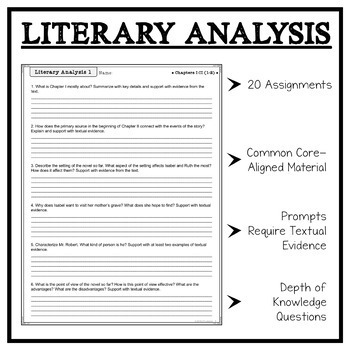Chains by Laurie Halse Anderson Chapter Analysis Questions
- Zip
- Google Apps™

Also included in
- This product is a comprehensive set of instructional materials for teaching a novel study of Chains by Laurie Halse Anderson. With these Common Core aligned materials, students will deeply engage with the novel and develop their literacy skills through literary analysis, fiction close readings, spyPrice $30.00Original Price $39.00Save $9.00
Description
For the novel Chains by Laurie Halse Anderson, the chapter analysis provides a framework for students to complete a deep literary analysis for every chapter grouping of the novel. The chapter questions are aligned to the Common Core State Standards and designed not only to have students practice literary skills but also demonstrate their comprehension of the text.
Digital Compatibility: This resource is also technology friendly! It can be utilized in classrooms where computers or tablets are central to instruction because the resource has been adapted for digital completion. The resource includes links for students to complete the assignments in Google Slides™. For instance, students can work with the documents in Google Drive™ or via Google Classroom™. With these links, you can have students complete their work online. All they will have to do is create a text box! There are links for every student work page (not mini-quizzes), making the format friendly not only for technology but also trees.
Chapter Analysis: For the novel Chains, this document can offer several different uses. It could supply homework, facilitate guided reading groups, or stimulate whole class reading analysis and discussion for each chapter. The document has 20 assignments - one for each chapter grouping of the book - and each assignment includes 11 questions aligned to CCSS ELA skills, such as:
• Identifying main idea and support using details from the text
• Identifying and analyzing parts of plot – how elements of a story interact
• Identify conflict and types of conflict
• Analyze how conflict affects characters and creates suspense
• Analyze character and make inferences about character motivation
• Identify and analyze symbols for their deeper meaning
• Identify themes of the text and explain the lesson learned
• Analyze the effectiveness of flashbacks and foreshadowing
• Analyze setting for mood and conflict
• Identify and analyze point of view
• Identify irony and the effectiveness of irony
• Make inferences based on textual evidence
• Analyze tone and determine the meaning of words, phrases, and figurative language
Visualization Section: Each assignment also sees students identifying an example of figurative language and drawing a visualization of their example. This is a great way to have students use their imagination but also get them to “see” what the author is trying to convey. NOTE: Modified for digital format.
Mini-Quizzes: The mini-quizzes are a way to test students’ comprehension of the text. This space can be used for the single question quizzes provided in the resource. There are multiple potential uses that could fit the needs of your classroom. (NOTE: The digital version is not formatted to allow for students to complete the quizzes online. However, as you have access to all the questions, you can still use the content and determine the best method to deliver it).
Answer Key: The key provides potential answers for every question asked in every assignment. This includes comprehension quiz questions and analytic questions. Of course, not all analytic questions have just one answer. Part of the strength of the analysis question is the room they leave for students to demonstrate their unique thinking. Therefore, use the answers at your discretion but know they provide a solid foundation for the type of performance that makes for quality work.
The entire resource and its inclusive set of questions allow for multiple potential uses based on your determination about when and where it would be most helpful, either in-class or for homework. All aspects of the assignments, though, are aligned to the Common Core State Standards in order for students to have ample opportunities to practice and demonstrate their knowledge across numerous, essential literary skills.
PLEASE NOTE: This resource is NOT EDITABLE! It is intended to be comprehensive, but if you have particular needs for your classroom, please contact me! (lauren@lit-lessons.com)
Need vocabulary resources for Chains? Check out this awesome resource!
Chains by Laurie Halse Anderson: Vocabulary, Activities, Quizzes, Test, Puzzles
American Revolution Spy Unit: Spy Readings, Techniques, Vocab, Activities, Game!
Interested in teaching other novels? Check out these resources!
Wolf Hollow by Lauren Wolk Unit: Novel Study, Tests, Vocab, Mock Trial, Projects
The Book Thief Unit by Markus Zusak: Comprehensive Suite of Materials for Novel Study
Refugee by Alan Gratz Unit: Comprehensive Suite of MaterialsPercy Jackson Lightning Thief Unit: 30 Days of Instructional Materials






